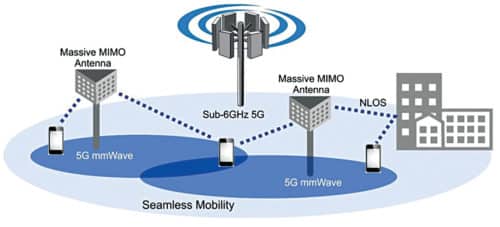The introduction of 5G New Radio or 5GNR has helped in improving wireless communication and offering better mobile services. With 5G communication, deployment of smart antennas has become crucial for the optimisation of coverage, capacity, and mobility support for apps and services.
From improving wireless communication and supporting better mobile services to enabling the full potential of the Internet of Things (IoT), the emerging ultra-fast mobile broadband standard 5G New Radio, or 5GNR, offers these experiences by ensuring faster speeds compared to 4G and allowing ultra-reliable multiple concurrent connections at ultra-low latency (less than one-millisecond delay).
As mobile network operators are planning to roll out their 5G network services, more complex antenna designs and deployment strategies are needed. Deployment of mobile edge computing (MEC) to enable processing at the edge of networks, as well as smart antennas, is crucial for the optimisation of coverage, capacity, and mobility support for 5G apps and services.
Traditionally, antennas have been passive devices that utilise materials like metal rods, capacitors, and conductors. But 5G differs from its predecessor wireless networks in the sense that it requires active antennas, driven by Multiple Input/Multiple Output (MIMO) and Massive MIMO (with 16×16, 32×32, and 64×64 configurations or even higher), in the coming years to increase the throughput. Unlike non-array systems, MIMO is used at both source (transmitter) and destination (receiver) for enhancing signal quality/gain since multiple signal paths are able to compensate for attenuation or blockage on one or more paths.
Besides MIMO, smart antennas use a few other key technologies such as beamforming too. In beamforming, radio waves are converted into beams by focusing radiofrequency (RF) energy radiated from the elements of a multi-antenna in a narrow beam and then transmitting to each terminal. Even then, line of sight is a problem as beamforming advantages are diminished with attenuation. These antennas also have smart signal processing algorithms, which can be used to track and locate the antenna beam on the target.
AT&T and Verizon in North America are already working on mmWave communications, sometimes referred to as extremely high frequency (EHF) communications.
But as higher frequencies need more power since an RF signal fades more than a lower frequency signal, the network configuration for 5G communications involves a large number of small cell base stations. Also, mmWave communication signals can be subjected to substantial attenuation or distortion during propagation loss due to obstacles (buildings, vehicles, etc), which necessitate more base stations in busy areas to avoid degradation of users’ experience.
Smart antennas are highly useful in establishing ultra-reliable communications for mission-critical applications in real time. There is an increasing demand for better voice, data, and machine-oriented communications as any problem related to communication can lead to misunderstandings in the event of a disaster or strategic mission and compromise safety.
In addition, applications such as robotics, connected vehicles (Vehicle-to-Everything (V2X) communication), remote surgeries, drones, or unmanned aerial vehicles (UAV) will benefit from the improved bandwidth and low-latency features once 5G antennas that are considered critical for enabling these smart city solutions are deployed.

In spite of several researches on 5G antenna systems, there have been multiple bottlenecks for antenna designers, including antenna performance, integration, power capacity, and production efficiency, to ensure reliable and interference-free communications. For example, movements of a user holding a mobile handset vary randomly (stochastic process) and frequently, resulting in changes in antenna inclination angles that lead to multiple pathways and fluctuating signal intensity.
For solving these issues, Huawei recently released a new technology (CableFree) for antennas. The technology aims to improve antenna radiation efficiency by nearly twenty per cent for better coverage and antenna power capacity by more than eighty per cent. The weight of antennas is kept low to simplify installation and reduce cost. It has already been applied to Huawei’s Munich Pro, Golden Mini, and London Pro series antennas, among others.
Startups like FreeFall Aerospace and Electronic Design and Development Corp. are also capitalising on this emerging standard and bridging the industry gap by combining advanced ultra-lightweight antenna technology with 5G communications capabilities.








